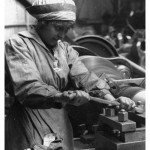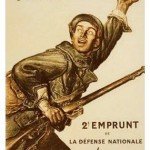
World War I was a total war, involving the governments, economies and populations of participating nations to an extent never seen before in history. This was distinct from the way ‘smaller’ wars had been fought, like the Crimean War (1853-56) and late-19th century colonial wars. In ‘total war’ – a term not coined until the 1930s, by German general Paul von Ludendorff – the entire nation was called into service, rather than just its military. Governments played an active and interventionist role, passing laws that would be intolerable during peacetime. Ministers and departments took control of economic production, nationalising factories, determining production targets, allocating manpower and resources. Conscription was introduced to bolster military forces and resources like ships, trains or vehicles were commandeered for military purposes. Wartime governments also acted to protect national security, by implementing press censorship, curfews and strict punishments for breaches and violations. They also made extensive use of propaganda, both to raise public morale and to raise money through war bonds.
Britain initiated total war from the outset. A week after the declaration of war, the parliament at Westminster passed the Defence of the Realm Act. This legislation empowered the government to secure the nation from internal threat or invasion, by handing it wide-ranging powers, including censorship, the authority to imprison without trial and the power to court martial and execute civilians. Control of the press and communication media was particularly stringent. London appointed ‘official’ military journalists and set up the War Office Press Bureau, which processed stories and distributed them to newspapers (very few civilian reporters were ever let near the front lines). Government agencies and the military were authorised to prevent the publication of offensive or dangerous material in newspapers and books; to open and censor civilian mail; and to tap into telegraph and telephone communications. As the war progressed, new restrictions were added to the legislation. Daylight saving was introduced to provide more working hours in the day. Alcohol consumption was restricted, opening hours of pubs were cut back and beer was watered down to reduce its strength. It became illegal to light bonfires or fly kites, both of which might attract enemy airships.

The British economy was also shifted to a total war footing. Under the Defence of the Realm Act the government could requisition any land or building deemed necessary for the war effort. Government control of the economy increased dramatically in 1915, in the wake of the ‘Shell Crisis’ (a shortage of artillery shells that contributed to British military failures on the Western Front; this shortage brought about strong criticism of the government and a change in prime minister). A new portfolio was created: the Ministry of Munitions, filled initially by future prime minister David Lloyd George. Construction of a massive factory capable of producing 800 tons of cordite a day was ordered, while other factories were nationalised and retooled for the production of artillery shells. British production of shells increased by more than 1000 per cent. The government also formed departments to coordinate other areas of the economy, including food, labour and maritime transport. Munitions aside, the other pressing demand was for food, both for the military and the civilian population. Westminster seized control of unused land for farming, including parks, commons and disused blocks. Rationing was introduced and food queues became the norm. Food became so valuable that it was a criminal offence to feed bread to animals or to throw rice at weddings.

In Germany, Walter Rathenau was put in charge of the Kriegsrohstoffabteilung, or War Raw Materials Department. As Germany started to suffer shortages caused by an Allied naval blockade, Rathenau’s skilful coordination of available raw materials and synthetic substitutes allowed industrial production to continue. But after two years these resources were severely depleted, and by 1916 production levels were falling. Military commanders Paul von Hindenburg and Erich Ludendorff implemented a series of reforms to double production of military needs. The Oberster Kriegsamt, or Supreme War Office, was formed to control and coordinate all aspects of wartime production, labour, industry and transport. The Auxiliary Service Law, passed in late 1916, empowered the government to employ and relocate any adult males it needed to meet its labour needs. More than two million men were forced out of the agricultural sector to work in weapons and munitions production. This had the desired military outcome, however the reallocation of labour saw production of both food and consumer goods plummet. These shortages, exacerbated by the ongoing Allied blockade, led to critical food shortages by the winter of 1916.
“Study of total war might begin with the premise that total warfare, the scourge of the first half of the 20th century, did not fall from the skies in 1914. Its political, military, economic, social and cultural origins lie in the 19th century, if not earlier. The Wars of the French Revolution and the Napoleonic Wars fundamentally altered the course of military history. For the first time since states had established monopolies over the use of armed force, mass mobilisation and broad social support became the basis of warfare. The great Prussian military analyst von Clausewitz was so impressed by this military revolution that he later wrote: ‘Suddenly war again became the business of the people – a people of 30 million, all of whom considered themselves to be citizens.”
Roger Chickering, historian
The French economy also mobilised to meet the nation’s war needs, though this was achieved with less government intervention than in Germany and Britain. France’s war production was left largely to groups of privately-owned companies, each responsible for a particular military necessity (there were fifteen groups responsible for producing shells, for example, and three groups for producing rifles). These consortiums received government orders and targets, then worked collaboratively to fill them. This system worked in principle, though France as a whole lacked the production capacity of Germany; it produced only one-sixth the amount of coal as Germany, and it was also hamstrung by the loss of some key industrial areas in 1914. Nevertheless the French achieved some spectacular increases in armaments production. By 1918 French producers were making 1,000 artillery guns, 261,000 shells and six million bullets per month. At the outbreak of war there were 162 aircraft in France; by 1918 there were more than 11,800. These striking increases made France the largest Allied producer of weapons and munitions, exceeding even the United States. Socially, the demands of the war economy took their toll on France’s workers, who suffered from stagnant wages and rising prices.

1. World War I was a ‘total war’ as civilian societies, economies and labour were all seconded to the war effort.
2. Britain’s Defence of the Realm Act gave its leaders extensive powers to reduce threats and harness the economy.
3. A critical shortage of artillery shells in 1915 led to a change in government and new measures to increase production.
4. In Germany, production was taken over by high-ranking officers, who reorganised industries and conscripted labour.
5. There were also dramatic increases in French military production, which exceeded that of the other Allies. Unlike in Britain, production was largely left to private companies working to fulfil government contracts.
© Alpha History 2014. Content on this page may not be republished or distributed without permission. For more information please refer to our Terms of Use.
This page was written by Jennifer Llewellyn, Jim Southey and Steve Thompson. To reference this page, use the following citation:
J. Llewellyn et al, “Total war” at Alpha History, https://alphahistory.com/worldwar1/total-war/, 2014, accessed [date of last access].
